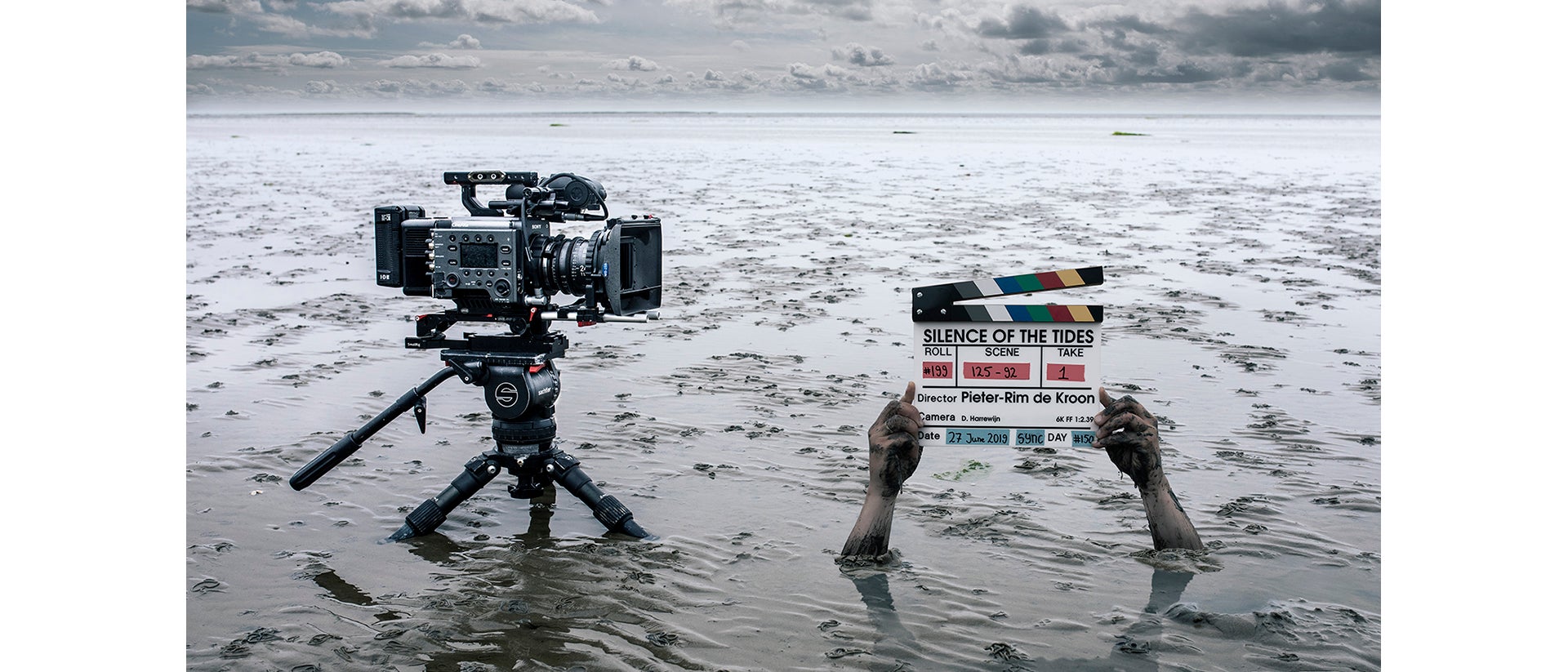
02-18-2020 - Case Study
Pieter-Rim de Kroon on "Silence of the Tides" - Shot on VENICE
By: Jon Fauer
As seen in February 2020 Film and Digital Times magazine, by Jon Fauer. www.fdtimes.com
Pieter-Rim de Kroon is an award-winning director, cinematographer and producer. His Dancin’ The Camera is about a tap dancer magically tranported inside an antique Parvo L. He shot most of My Old Handcranked Camera with a restored 1900s Kine-Messter. My friend Ruud Dobber of Vocas introduced us because Pieter-Rim just completed Silence of the Tides, an epic feature documentary on which he was director, co-writer and second cameraman. The film is scheduled for release in mid 2020.
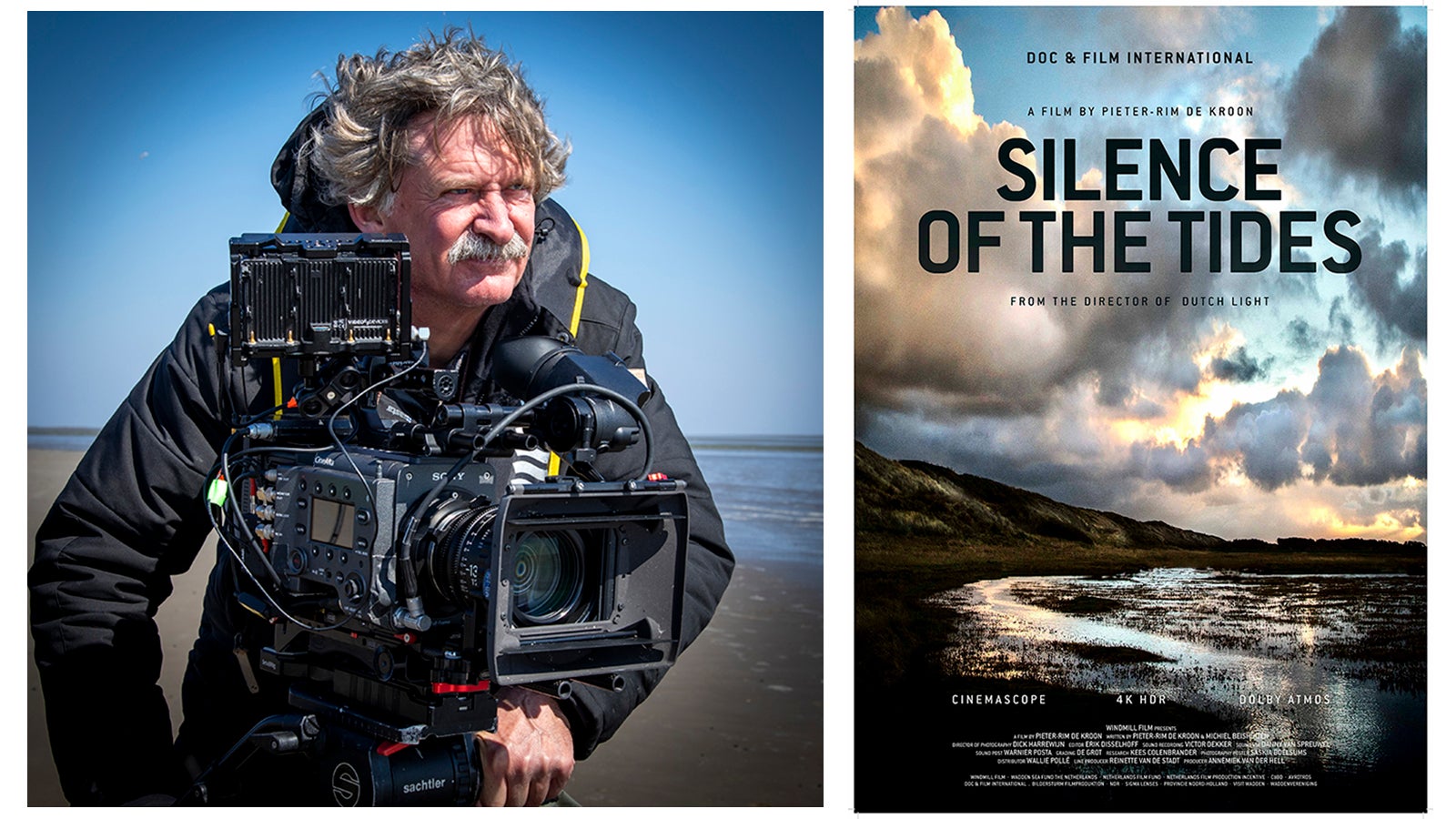
Pieter-Rim describes Silence of the Tides as “a cinematic portrait of the largest tidal wetlands in the world, the Wadden Sea. The film plays witness to the rough yet fragile relationship between people and nature as it pulsates with the inhaling and exhaling of the tides. It’s a hypnotizing, large-screen look into the cycles and contrasts of the seasons: life and death, storm and silence, the masses and the individual. All this is set against a larger than life backdrop of sky, water, wind, mist and constantly changing light.”
The Wadden Sea is a UNESCO World Heritage Site. It is the largest unbroken system of intertidal sandbars and mud flats in the world, consisting of tidal channels, shoals, sea-grass meadows, mussel beds, salt marshes, estuaries, beaches and dunes.
Here is the story of the making of the film: sky, mud, sand, cameras, lenses and a very resilient crew. Pieter-Rim is such a good story-teller, my questions have been replaced with titles.
Background
Pieter-Rim de Kroon: It started towards the end of 2016. A number of people were interested in doing a film project about the international Wadden Sea area. One of them was the Dutch Wadden Sea Fund, which is linked to the Dutch Film Fund. They invited pitches for a film. I was called by my producer at Windmill Film, Annemiek Van Der Hell.
I had visited the Wadden area many times in the past and had been thinking for many years about this concept. And that brings us to the basic concept of the film, Silence of the Tides, and the story of a tidal process that happens there every six hours. I see this tidal process as a breathing in and breathing out process, low tide and high tide, ebb and flood. This breathing cycle is the main subject and the constant awareness of this process makes it the main character of the film.
It’s not a traditional documentary: no dialogue, no interviews, no voice-over, no narration, not even music. It has everything to do with observation. I like to call it radical observation.
Silence of the Tides is a film about the relationship between people and nature. So human beings play an important role. We meet all different kinds of characters on the islands and in the middle of the Wadden Sea. Everybody relates to the quality of life in this area and its tidal process.
Locations and Shooting Days
The area stretches from the Dutch coast in the Northwest part of the Netherlands towards the West coast of Germany, to the West coast of Denmark. This whole area stretches along 500 to 600 kilometers of coastline and it is an area of 10,000 square kilometers, with 43 islands. I spent about 8 months doing research, location scouting and talking to people. The financing of this international co-production took another couple of months.
The cinematography started in the beginning of 2018. We shot for six seasons, finishing in July 2019. We did about 150 shooting days and then an additional 50 second-unit nature photography which always takes a lot of time. Editing was completed by mid-summer 2019.
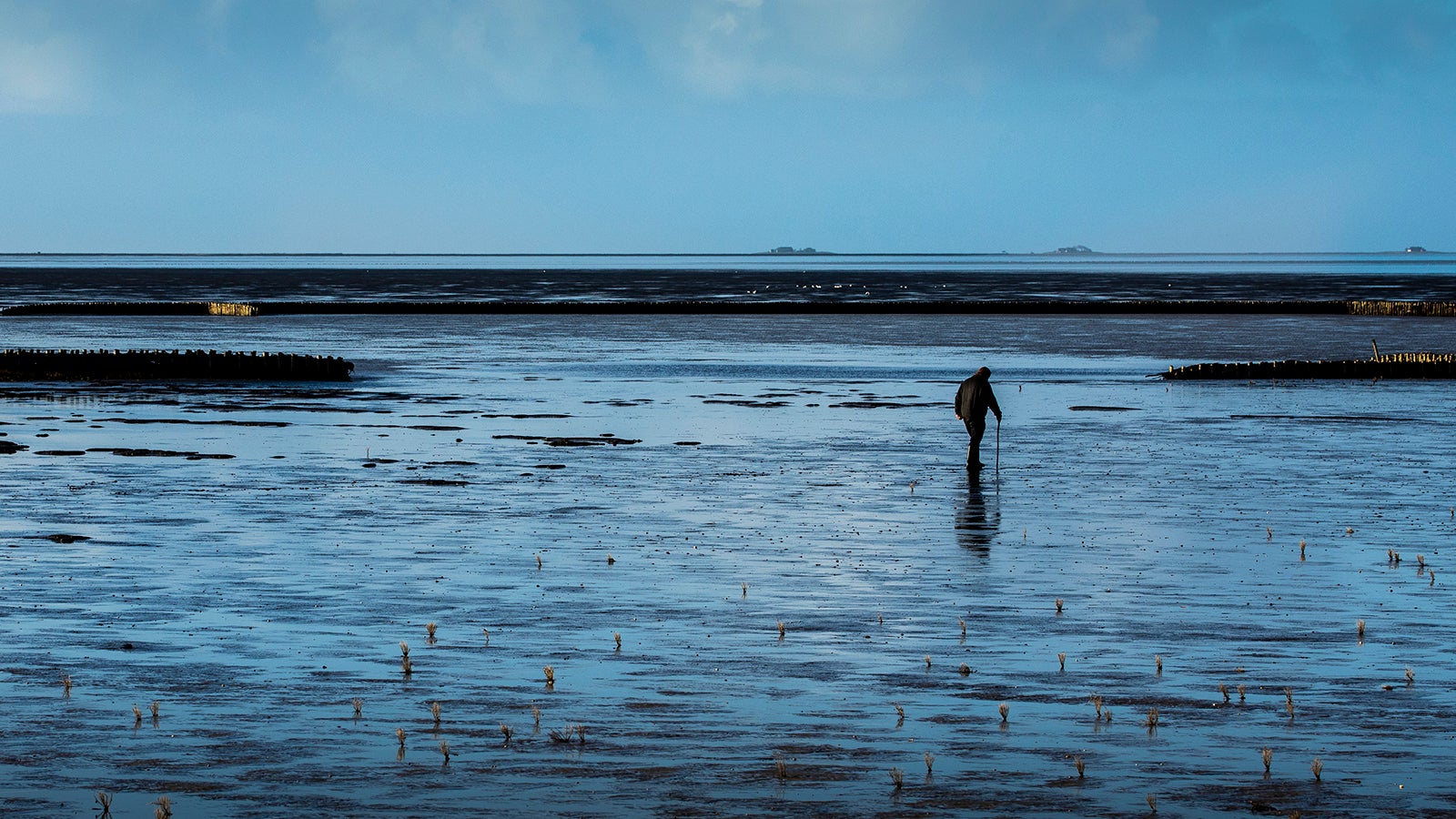
Living and breathing the film for two years
We were living and breathing salt water and our feet were in the mud. There was a lot of maritime shooting. We started with maritime training, safety, security, rescue and first aid with our basic crew. Selecting the crew members was an important thing because we needed people with outdoor experience. You can’t do 150 days of shooting during 6 seasons with crew who are not used to tough conditions. I told the crew that the days could be really long and wet and there would be no cozy restaurants in the middle of the Wadden Sea and many times they have to pack their your own meals.
We lived on boats, in small hotels, in small houses and sometimes in a camper. Many nights were on small boats. We would often wake up at low tide, aground in the middle of a sort of a muddy desert with 360 degrees of mud and water around us with a 360 degree view of the horizon. And at low tide, you get out of the boat and are in the mud. We did a lot of shooting in these muddy areas. You get the feeling that you are on a different planet. There are a lot of surrealistic landscapes.
The Crew
We usually had a small crew: director, director of photography, camera assistant, sound technician and production manager. I tend to keep the crew as small and flexible as possible. At the same time, we sometimes had one or two second unit wildlife nature cinematographers operating on their own. Some days became more complex with camera grip and rigging, construction and extra lighting with a gaffer and a best boy. There were a few days with a big crane and remote head. But basically it was quite a small documentary crew.
Choosing the Sony VENICE camera
I started my career as a director of photography at the beginning of the 80s working in cinema newsreels where I shot everything on 35mm film negative with an Arriflex 2C. For me, quality always has involved 35mm motion picture film. When I shot for cinema newsreels, I saw my results every week in the big screen cinema. It made me aware of camera handling, exposure, focus and framing.
And so, for this film, the image quality was key to the concept I developed. It’s a film with a gradual approach of discovery. In a lot of situations, nothing really happens. The camera is just there observing. We did really wide shots with an endless horizon of water and mud around us, changing under the light and the effects of the wind in this landscape of gray textures and everything related to gray. Therefore, I really wanted to have the highest image quality. When we started prepping for this film, originally I wanted to work with the ARRI ALEXA 65 camera system. But imagine the rental costs and data handling for 150 shooting days over one and a half years.
During our prep period, I was talking to Ruud Dobber, the CEO of Vocas in the Netherlands and at that moment, Sony was introducing their Full Frame Sony VENICE camera. I was intrigued not only by its Full Frame sensor, but also its new color science and extremely wide exposure latitude. I thought this could be a really interesting camera system to try. We started talking to Sony and ended up being the first film production in Europe to shoot a long production on the VENICE camera. It worked out really surprisingly well. I say surprising because some people advised me not to do it because this was a brand-new camera, untested on long feature productions, and this was going to be a rough and wet and salty salt-water shoot. They were unsure whether it would be reliable. But somehow I had a good a good feeling about the VENICE and we just started working. After the first six months of continuous shooting, we didn’t have one single problem with the entire camera system.
That was really quite amazing because we subjected the camera system to everything that might put it out of commission. We rigged the camera under a Falcon F-16 jet with many G-forces and air speeds of 600 to 800 mph. After every day of sand, salt, wind and spray, our camera assistant derigged and cleaned everything.
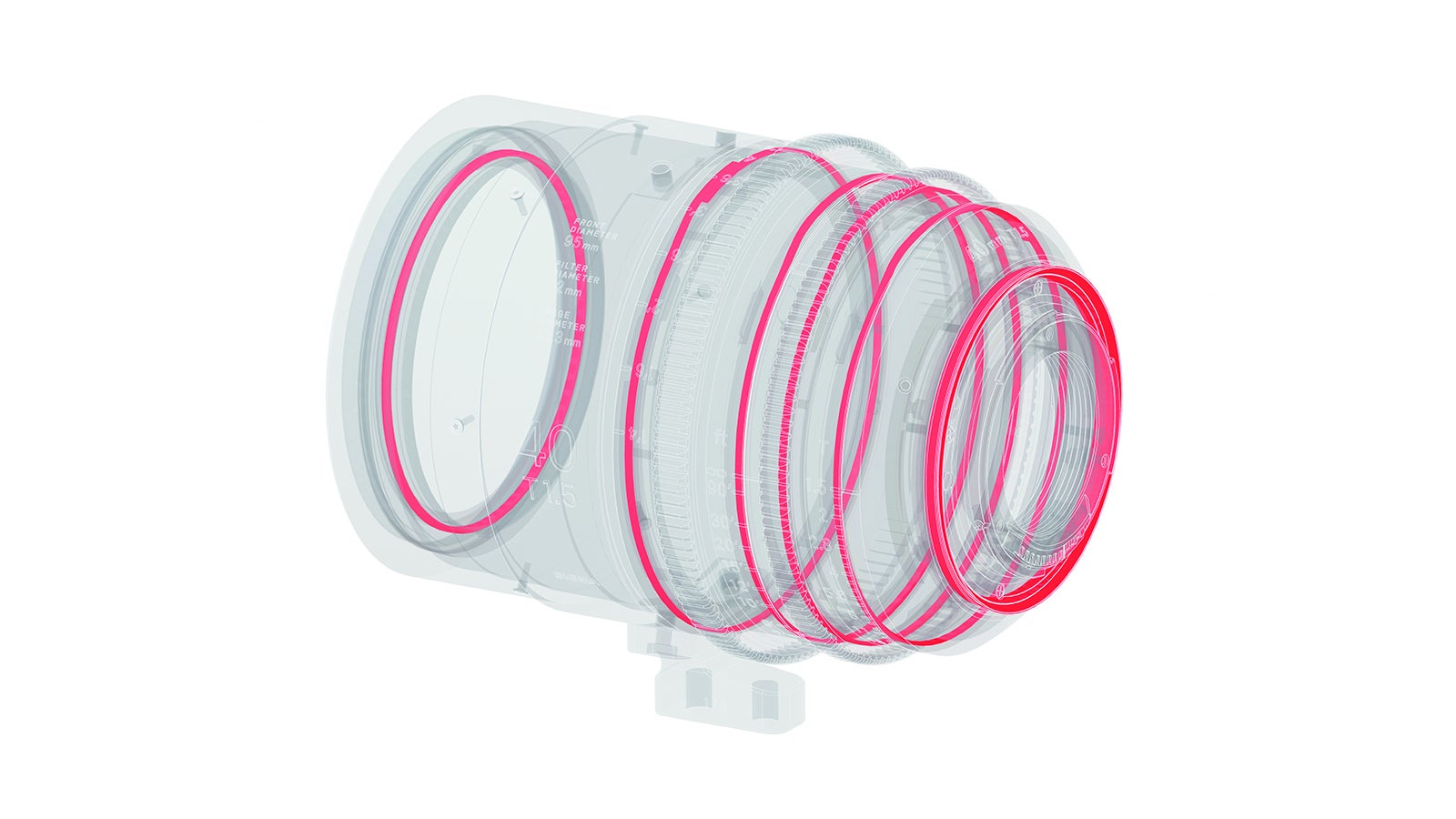
Engineering drawing courtesy of SIGMA showing dust and splash-proof sealing inside their 40mm T1.5 FF High Speed Prime.
SIGMA Full Frame High Speed Prime Lenses
As I have done with most of my previous films and documentaries, I always shoot on prime lenses. I don’t like to use zoom lenses for a couple of reasons. I find that prime lenses are much more interesting. Using prime lenses enables you to have a very consistent style in the film. You don’t mess between a 24mm and a 28mm focal length as you would with a zoom. You just stick to the available focal lengths there are. During prep, we tested all the major brands. We required primes that were Full Frame, lightweight, and weather-sealed. Also, the SIGMA Cine Primes are small and they’re easy to carry. That’s an important thing because we were shooting with a three to four member crew.
We shot a lot of the wide landscape scenery in backlight and the lenses handled internal reflections from the enormous amount of highlights in the water and bright skies very well. The sharpness and contrast made the landscapes come out on the cinema screen the same way you would experience it if you were there yourself.
SIGMA Weather-Sealing
We found the SIGMA FF High Speed Primes were quite interesting because they are among the few cine lenses that are well-protected and weather sealed against dust and spray. Of course, we did tests comparing them to other lenses and we liked what we saw with the SIGMA lenses. They have a slightly smoother, slightly warmer look. We tested the complete combination of lenses, camera, exposure and post production. We shot the whole film on SIGMA Cine Primes.
Lens Tests
That was quite an important reason to work with the SIGMAs. We did some serious tests and when we projected our tests on a big screen we were really happy with them. That’s another thing about lens testing. Although I have a technical background, I am not so interested in looking at lens charts and MTF curves. I like to shoot live action shots under different conditions. I output the whole thing to a color correct master DCP. So, I go to a big theater and then I project the results from the DCP master and then everything follows from there.
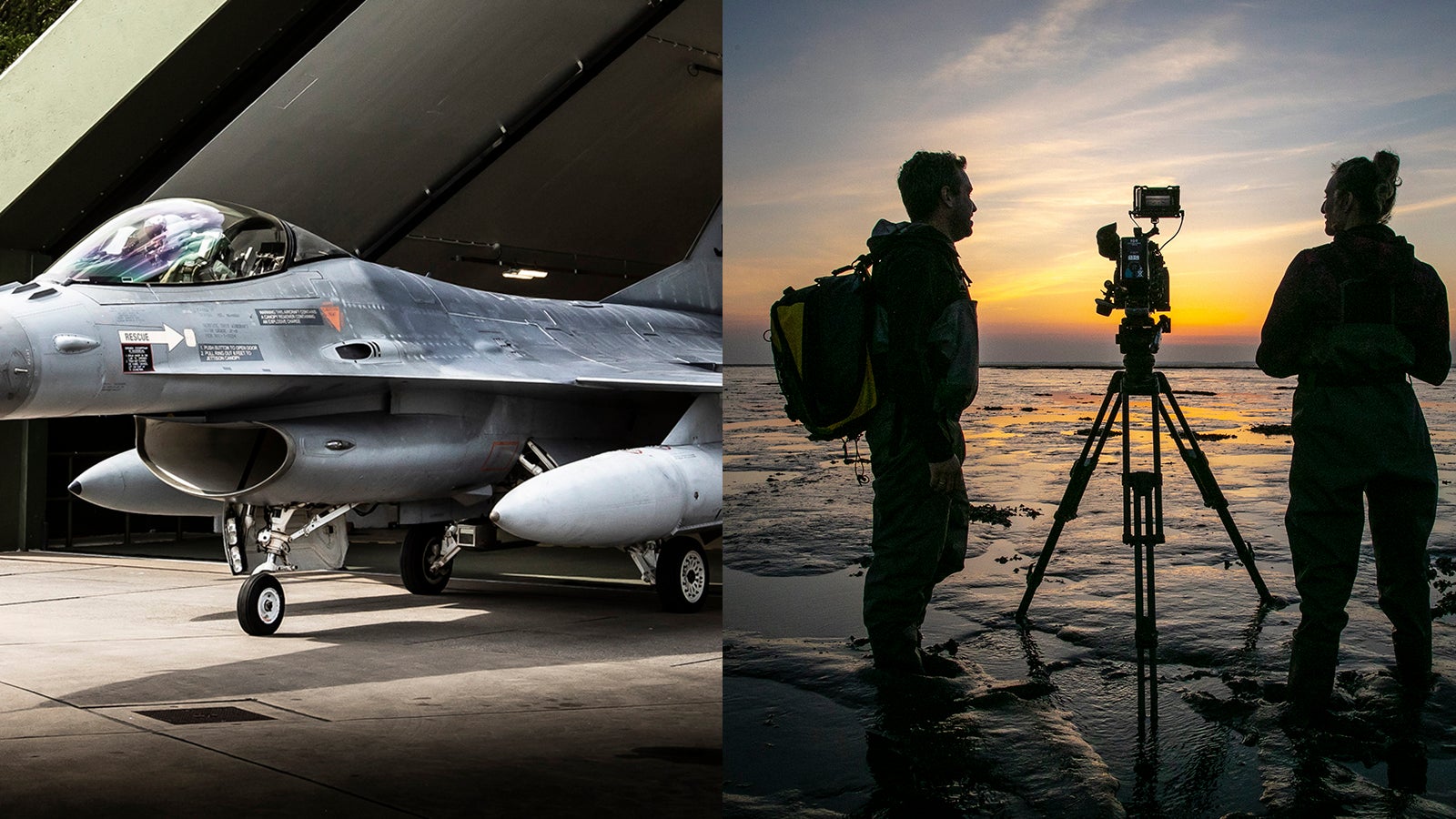
Pioneering with new equipment
You need some luck as well. Everything went well together. We had very close contact with our camera rental company, who are all personal personal friends, with Vocas, the dealer in the Netherlands, with Sony and with SIGMA.
150 shooting days: Buy or Rent?
We did not buy. That’s always an interesting discussion. It’s always a money thing when financing a documentary with as many shooting days as this. If we had bought the camera and lenses, maybe in the end, it would have turned out to be slightly more attractive financially. But then there’s the whole matter of service. If we dropped our expensive, owned camera in the water, then there is no backup. That’s why we think the relationship with a professional rental company is very helpful. If you have problems and your camera is out of order because it’s dumped in the water or because of other reasons, then you just make a phone call to your rental company and they set you up with a new camera within 24 hours. Our rental company is called Het Raam; the exact translation is The Window. It is run by Edwin Verstegen, a friend and former cameraman who is very involved in everything to do with new, digital techniques.
Vocas
Vocas is a distributor and dealer in the Netherlands for the main brands like ARRI, RED and Sony cameras as well as lenses, support and accessories. You could also say that they run the market. They also are developers and manufacturers of a lot of camera accessories like matteboxes, bridgeplates and follow focus devices. I have a long term relationship with Ruud Dobber, the CEO of the company. He helped sponsor us by supplying the rigging and accessory systems.
Ruud was involved in this production. He liked the concept and felt it should be supported because it’s a documentary. I talked to him and he was enthusiastic about the whole project. Then he talked to Sony and he arranged for the first Sony Venice to be available for our production.
Vocas also was responsible for a particular sequence in the film. One of the islands in the Dutch Wadden is called Vlieland. The islands of Vlieland have a huge, sandy surface. It looks like a desert. It is the largest sandy area in the whole Northwest part of Europe. At that location, the Dutch, American, Danish and German Air force use it for training and target practice. We have a sequence in the film where we follow a pilot in his F-16 from the airbase, through the clouds, towards the Island of Vlieland to do some heavy shooting practice. We wanted to share this experience. What does an F-16 fighter pilot experience when he is approaching at high-speed through the clouds low over this Wadden Sea area? How does it look and how does it feel ? It took us a lot of time, with many different cameras—ground to air, air to air, and air to ground shots. We hard-rigged the Sony VENICE with a 35mm SIGMA prime lens under the F-16 aircraft. There were many aircraft and safety rules, and the specially wedged base, sliding plate and secure battery rigging construction was done by Vocas.
We didn’t use any stabilizing system. From previous experience, I knew that the F 16 aircraft is extremely stable. It’s totally different than a regular aircraft or helicopter. So we just made a rigid connection from the camera and brackets to the F-16 and this turned out to be extremely stable shooting footage.
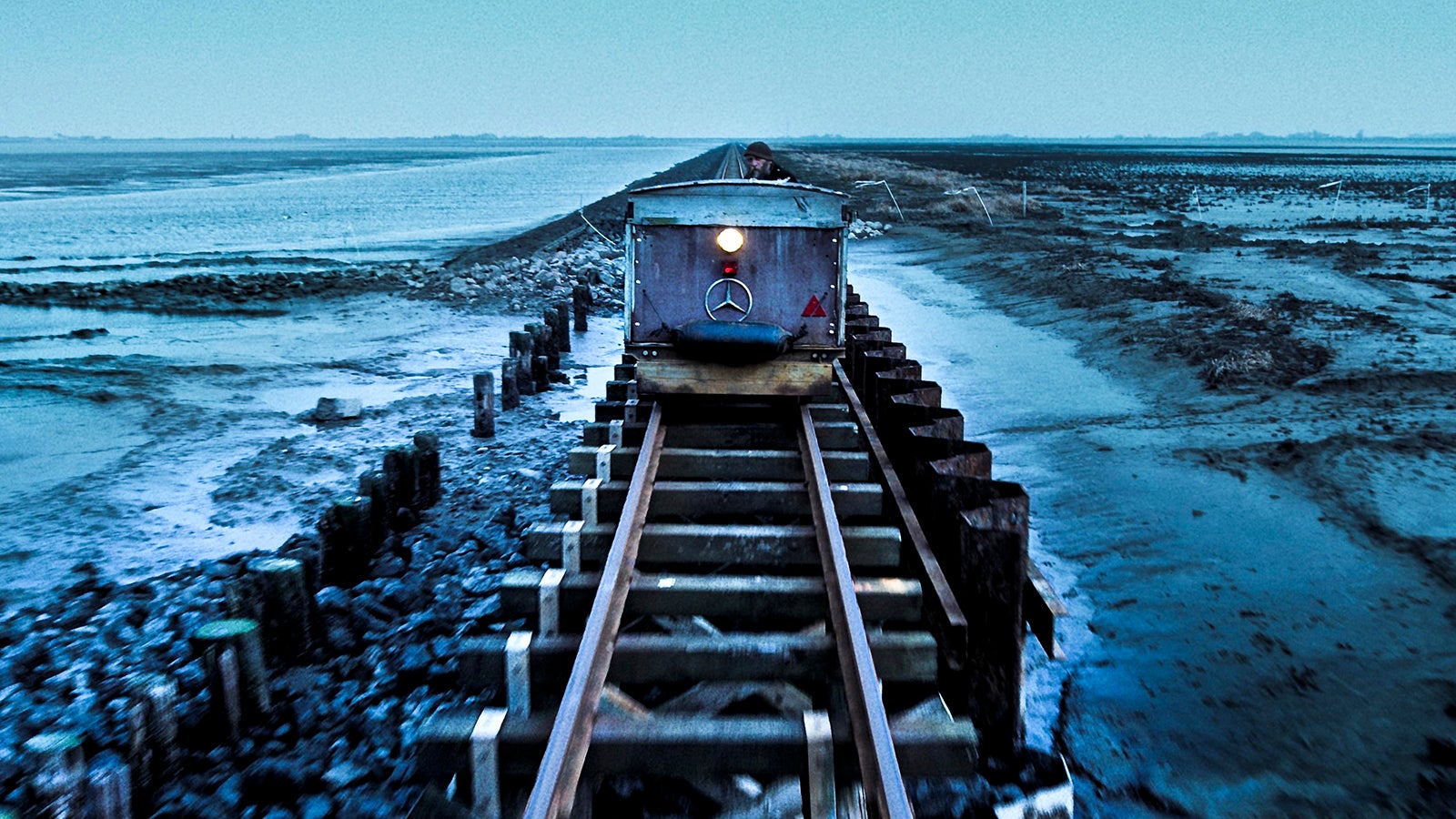
Hannie the Postman driving his Lore through the Wadden.
Protecting front lens element from dirt and insects
We protected the lens with a front safety glass in front. That was important because during taking off and landing at high speed, small stones and rubber were kicked up by the front nose wheel and hit the lens. But the moment you were airborne, the speed was so great that there was an aerodynamic effect and nothing hit the lens, even when it was raining. We were not allowed to be in the F-16. We were also not allowed to operate it remote controlled because of safety procedures. So we just inserted the biggest data card in the camera, attached a double set of batteries and started the camera before take off. And then 40 minutes later when it touched down again, we had about 40 minutes of footage. It’s just old school but it worked.
SIGMA focal lengths
The 24mm SIGMA FF High Speed prime was used for most of this film. For extreme wide angle landscapes, we liked the 14mm. We also had the 20, 35, 50, 85 and 135 mm primes. SIGMA has added more focal lengths afterwards.
Sony firmware from version 1 to 3
We started with firmware version 1. It was only possible to shoot 6K in 3:2 X-OCN ST format. We were very happy when version 2 made it possible to shoot 6K 17:9, doubling the number of minutes on a card but still leaving us the possibility to reposition the image outside the 2.39:1 frame in post. We had no exposure tools in the camera with firmware version 1, leaving us to expose everything using a light meter. Eventually the exposure tools came with firmware 2.0, but we never gave up the light meter.
We were very happy with the latest software because we could use the pre-record function. Because there was a lot of nature photography, you are waiting and waiting for something to happen. That’s why the pre- record is important. We also enjoyed going to higher frame rates.
Filters
We rarely used any filters. Basically we didn’t use polarizing filters because you lose the highlights on the water. And we liked having all the original contrast in the final result.
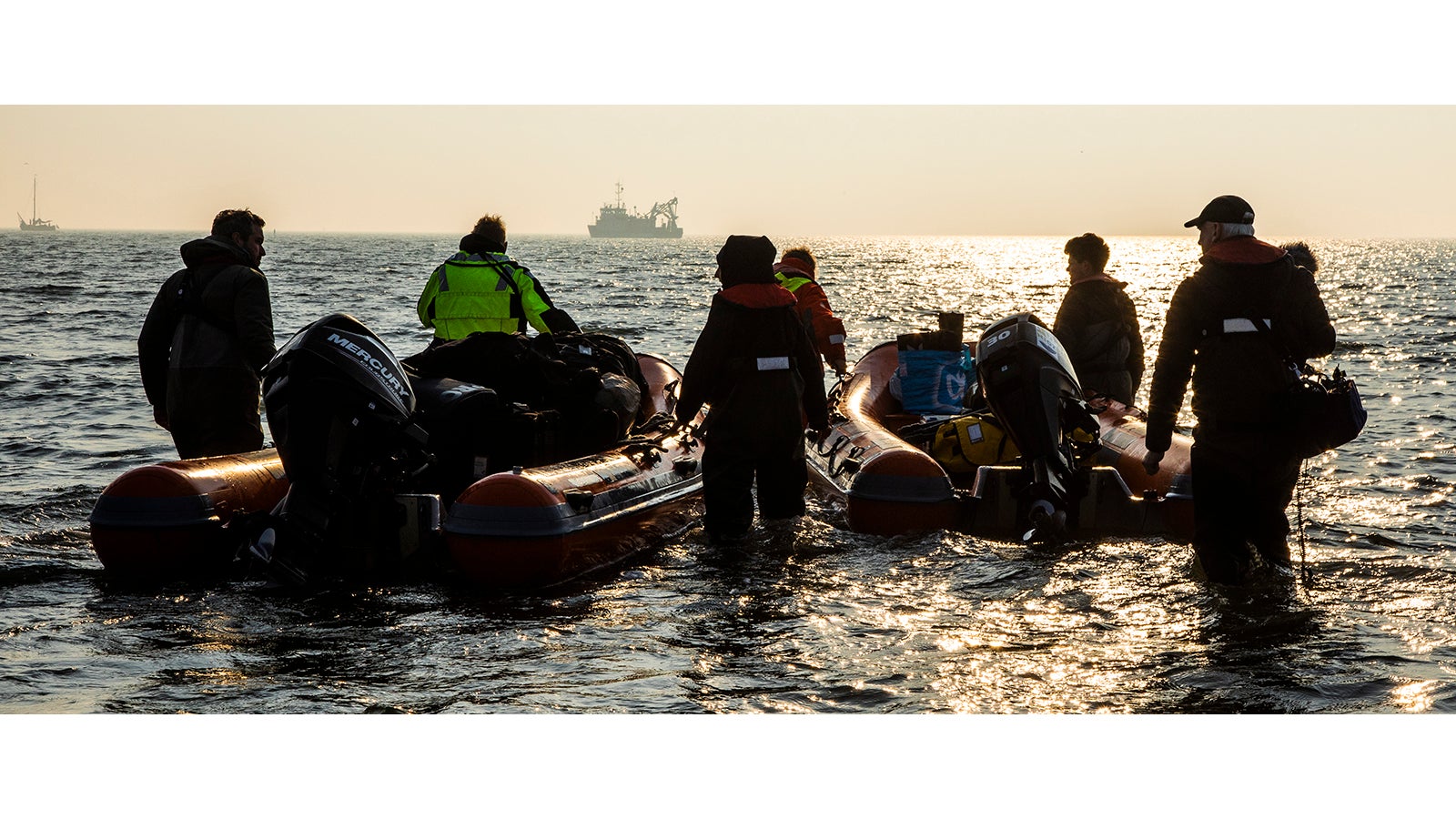
Recording and Post Production
We used Sony X-OCN Standard recording format. [X-OCN (eXtended tonal range Original Camera Negative) file sizes are much smaller than typical camera RAW and offer 16-bit linear encoding.]
In conforming the original footage and online, our 6K data files were transcoded to 4K DPX files. Grading was done on a Baselight system and it worked well with DPX files. I graded the film with a very talented young Dutch colorist named Joppo at a company called De Grot.
Editing
It took us something like 75 editing days. Together with my editor Erik Disselhoff, I have a process established from previous productions with long shooting schedules. Every two months, we go into the edit suite and rough edit two or three scenes. Then we go into post production, grading, transferred to a Digital Cinema master and project our rough edited scenes onto a large screen cinema. This is really important because you get into close contact with what you’re doing. You see your results, the visual approach and timing. This teaches you a lot and is very valuable. After wrapping the shoot, we had almost 30 scenes that we had already rough edited. That was a really good start to the whole offline.
Footage
I think we shot about 120 hours. We shot it like a documentary, but it was more or less a feature documentary. We prepared for months and some sequences were precisely scripted and storyboarded.
Release
It will be released in cinemas in 2020. The distributor is Windmill Film Distribution. The sales agent is Doc & Film International. We had some preview screenings at the festival in Cannes. There will be an international film festival release and international distribution. We put a lot of attention into a delicate and dynamic three dimensional sound design in full Dolby Atmos. For us, that’s important because the impact on a large screen with a lot of attention on the photography and full Dolby Atmos sound should make for an interesting viewing experience.
Widescreen 2.39:1
We shot for a 2.39:1 widescreen aspect ratio. We mostly didn’t do any operating or movement with the cameras. I call this radical observation. It has to do with what happens in the human mind because change increases our awareness. The human eye perceives differences. In the area we were shooting, a lot of really intricate but small processes are happening during the change of the tides. A small bird may be in the left side of the frame and a small insect right in the frame. The moment you start moving the camera, you miss important and delicate processes. My approach was to not mess with the camera, but to put the camera on a solid base and just observe. Of course, in some situations the camera was moving because it was rigged under an F-16 or a train car. We mostly observed and didn’t move the camera because the whole film happens in front of the camera and you should not involve the camera.
Hannie the Postman
The locomotive is called a Lore. We shot with a MoVi stabilizing system from another train. Our main character is Hannie. And he is the postman of a couple of small islands near the West coast of Germany. We follow him during the film and during the seasons He travels on a very small powered railroad truck. It’s like a small, self-powered locomotive thing that runs on narrow-gauge railroad tracks. These small islands in Wadden can only be approached on small railroad tracks. They can go through the mud, through the water. Sometimes the rails completely disappear when it’s extra high tide. So you cannot approach these small islands by boat because it’s too slippery. There are maybe 25 to 30 families who live there and every family has its own small locomotive. We filmed our famous character Hannie the postman during several seasons throughout the year. These rails and traditional old locomotives are really shaky, shaky, shaky. So we rigged our Sony VENICE onto the MoVi, but it was still too shaky. Then we connected the Movi to a shock absorber. We still had to do some image stabilizing in post production as well.
Light and horizons
The position of the horizon in this film is something I thought a lot about. I did a feature documentary called Dutch Light about the myths and phenomena of the famous Dutch light, which has its origin in 17th century landscape paintings. For that film, we did a lot of research on where the horizon should be in all the wide shots. And then we looked at the Dutch landscape painters. We decided to put the horizon very low in the frame to experience the effect and the way the light manifests itself in the landscape. For Silence of the Tides, we did it the other way around, putting the horizon high in the frame to accentuate the muddy salt marshes of the Wadden areas in the lower 2/3 or ¾ of the frame. The funny thing is when you have the horizon high in the frame, it feels like somebody is pressing on your shoulder. As a result of this, the viewer comes closer in contact to the essence of the film—the mud flats, salt marshes and landscapes. I think a part of the magic of the film is in the carefully selected position of the horizon.
Could have been an assistant’s and rental nightmare
Our crew took great care of the equipment and the rental house was very pleased when everything was returned in good condition after so many shooting days.
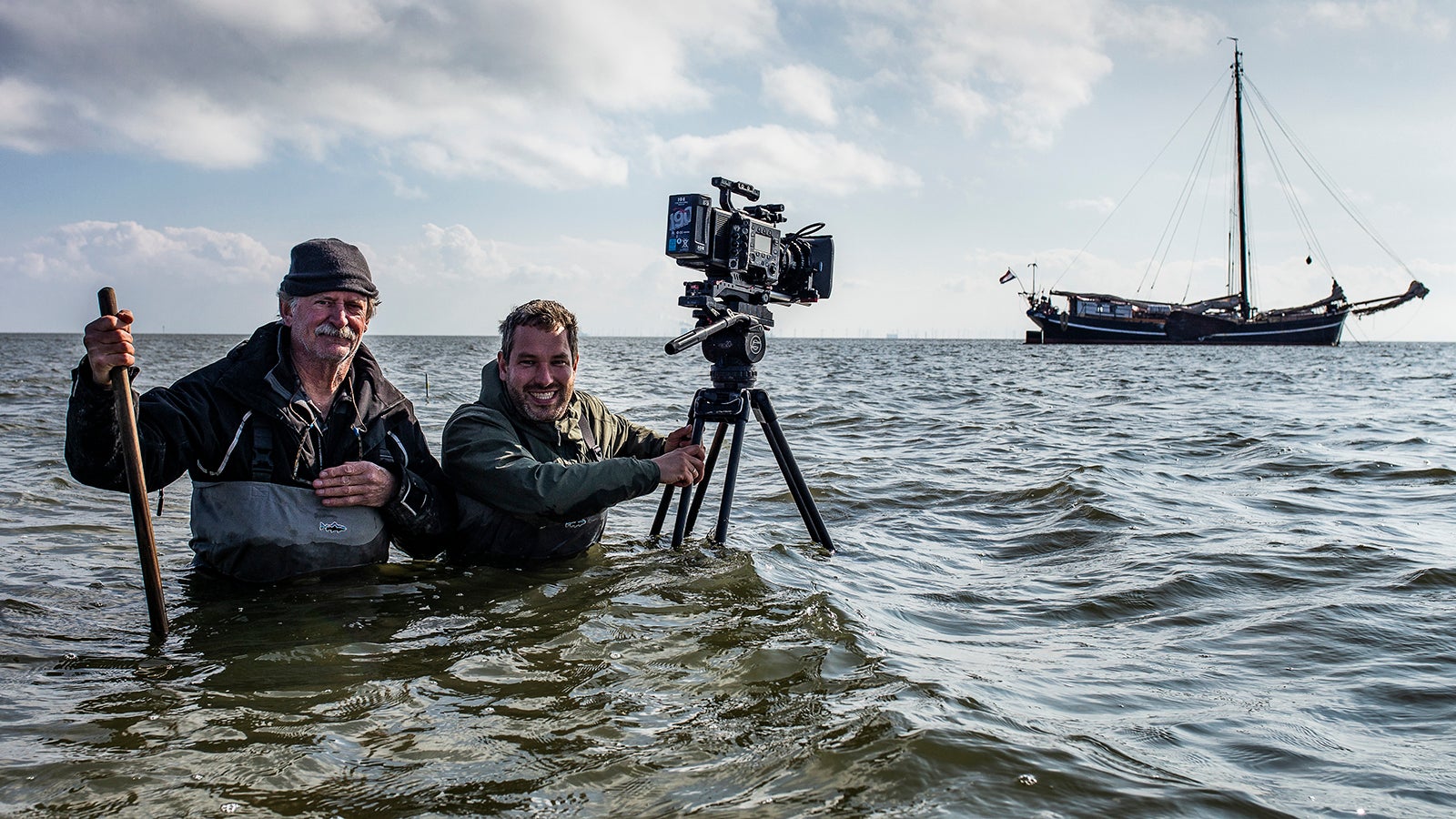
Cinematographer Dick Harrewijn (right) and Director Pieter-Rim de Kroon (left).
Dick Harrewijn, Cinematographer
Jon Fauer: How was it working with director Pieter-Rim de Kroon?
Dick Harrewijn: His way of storytelling and his feeling for light and framing was very inspiring and resulted in many great images in the film. Pieter-Rim had very specific wishes like shooting the whole film on prime lenses, with long takes of landscapes and an absence of moment in the shots. These choices made the film what it has become: a distinctive piece of cinematic observation. I think the absence of camera movement is also part of allowing the viewer to looking closer, scanning the screen for details. It adds to the relationship between the viewer and the screen much more than when the camera dictates where to look.
You also have a background in wildlife cinema documentaries. How were you able to use that experience on this film?
Although Silence of the Tides is a film about the relationship between man and nature, the nature part itself and wildlife also played an important role bringing in my wildlife documentary experience. It’s about understanding nature, outdoor experience and endless patience.
We spent multiple weeks trying to film the rare, but very aggressive, fights between male seal bulls and the birth of the seals in midwinter. We also spent days filming birds on remote islands that are closed to the public and are without any facilities.
Was this the toughest job you ever did?
Every job has its own challenges and difficulties. But this film was definitely the most challenging for the crew, the equipment and above all logistics. We had some really challenging weather and conditions, but eventually most of these led to the most interesting images of the film. But I have to say, this project has also been the most fun and cinematographic project of my career so far.
You had 2 cameras and probably no DIT. How did you wrangle/manage the data? Did you offload the data card each night? Laptop, hard drives, backup?
Before the shoot we were indeed worried about this and at first we planned to have a DIT with us for most of the time. But the more the story developed and the more we made decisions considering the equipment, we decided that we would treat the footage as traditional analog motion picture film stock to start with, shooting as limited as possible and thereby keeping the data low. Also after testing we found out the Sony X-OCN codec was a great option for shooting with much smaller file sizes but keeping the possibilities of RAW footage. The VENICE camera with the AXS-R7 recorded the data to AXS cards.
Every evening I would copy the data myself, often on a boat or hotel room. Doing this myself also offered me a first look at the footage, directly seeing what we shot during that day. At times we even used the moment together with director Pieter-Rim de Kroon to discuss the footage and talk about the next day.
How did you manage the data?
Using a 2017 MacBook (it must be the one with four USB-C ports) and the Sony USB-3 card reader for AXS cards, I copied the footage to G-Tech 1TB SSD drives. I’ve been using Hedge software to copy my footage for years and I’ve been really pleased with the speed and security it gives. Using this setup, it took about 35 minutes to copy one 512GB (30 min 6K XOCN ST) card to two SSD drives at the same time. Typically it was just a matter of opening the laptop, connecting everything and before we had a chance to drink a good whisky in the galley to celebrate the day, the Hedge App on my phone said the footage was already copied. We had plenty of inexpensive SSD drives and we kept both copies until all footage was copied to two different locations in Amsterdam by our data manager Govard-Jan de Jong. For most of the trips we were able to also keep the original camera card until the footage was copied at the office in Amsterdam as a third backup.
How did you view the footage?
I’ve mostly used Sony RAW Viewer. The 2017 MacBook I was using managed to do 24 fps X-OCN ST playback at 1/8 resolution which I think is fine for field checks. For focus checks I just looked at full res at 4 or 8 fps playback. I like the Sony RAW Viewer for just that. It works brilliantly on a laptop and it does what it is supposed to do. (I only wish there were a ‘create still’ button in there just like in REDCINE.)
It did not play back the audio though. Sometimes I used DaVinci Resolve for quick grading checks or to apply my own LUTs.
As the cinematographer, how do you think audio and especially Dolby Atmos help to tell the story in this film?
The effect of Dolby Atmos soundtrack was a great surprise to me as a cameraman. It is not only about more speakers in the theatre and more audio channels, but most of all it’s about placing the sound where you want it to be. To me, Dolby Atmos is where sound and image comes closer than ever before. Previously it was mostly the photography that directed the eyes of the viewer, but Dolby Atmos directs the eyes of the viewer to every spot on the screen. Whether it is a bird calling or the arm bracelets of a woman moving, you can locate them on the screen with your eyes closed. The sound is not coming from left, center or right of the screen but can be placed exactly on the screen where the origin of the sound is coming from. To me, the use of Dolby Atmos in a film like this adds to the story, the immersive viewing experience and very much complements my work in cinematography.
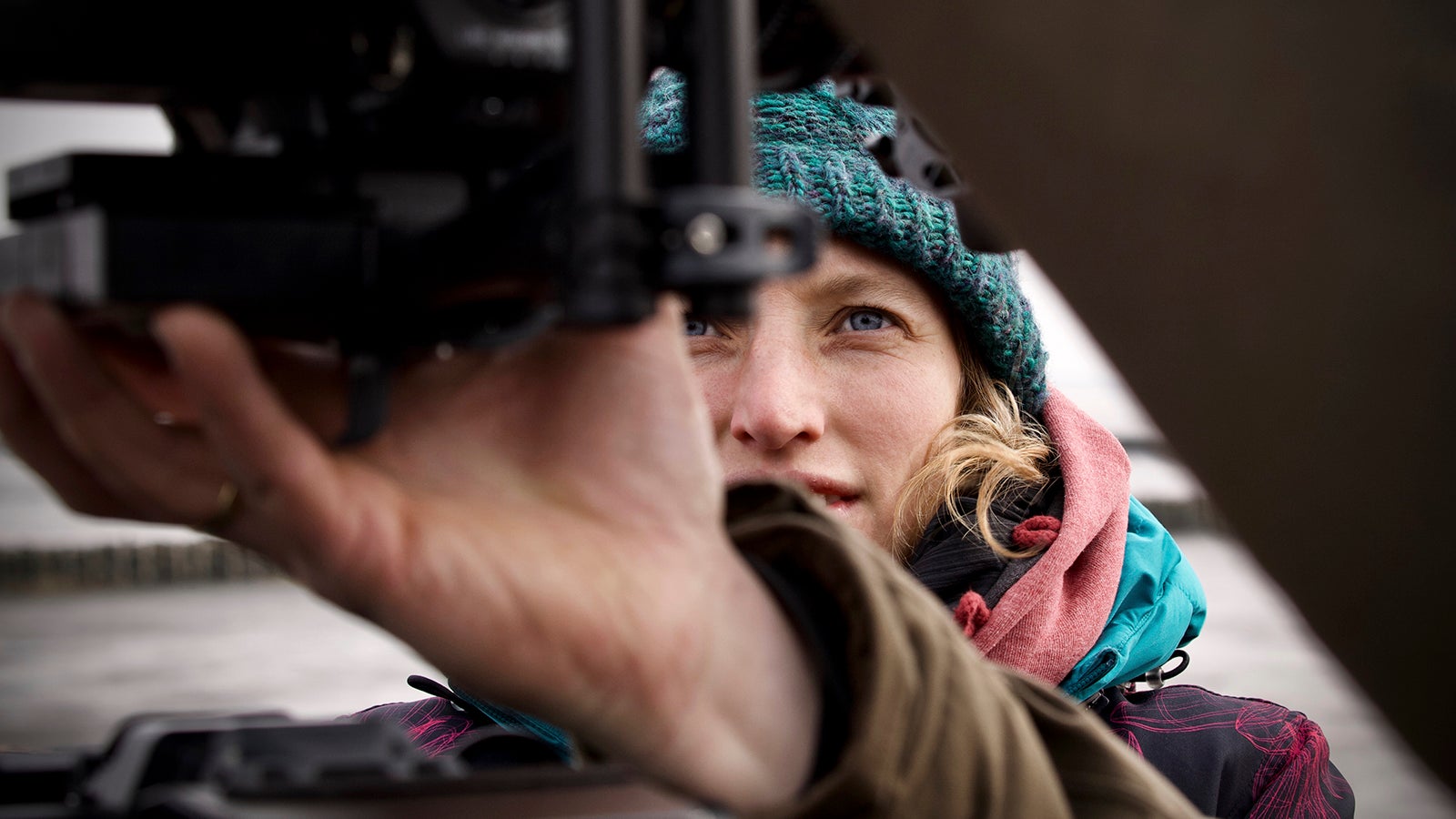
Amrit Khalsa, Camera Assistant
Advice on working in conditions that would make any camera or lens designer cringe: wind, salt, spray, sand, cold, wet…
Amrit Khalsa: All of the shooting days I worked on were outdoors in the elements that were indeed usually windy, wet and cold. For some shots we would have the camera out on the wad on a tripod (that we had secured to stay put) while the tide came in, which is quite cringe-worthy the first time around.
A wad is a tidal mudflat that appears when the tide has gone out. At high tide it is covered by water but when the tide goes out you can often walk across it, as long as you make it back to land before the tide comes in again!
Other times we were on a sailboat trying to get to the best slenk (tidal channel) to shoot, but to get to those we would have to get dressed in our full waadpak (waders), hoist the camera and lens bag off the sailboat onto a small dinghy and then steer all of it including ourselves to the wad where it had to be unloaded carefully not to let anything touch the water. We carried our lenses in a backpack that could be quickly opened and closed to minimize sand and salt blowing in.
Once on the wad it was almost quicksand-like, so you had to be very careful not to stand in one place too long because it would suck your boot down and you could not get your foot up again without physically digging it out, which led to entertaining situations. I think the most cringe-worthy shots occurred with the F-16 fighter planes doing test bombing on old shipping containers. We were standing on the control tower with the VENICE and we had a B-camera set up out on the wad to shoot the explosions. It was outside the danger zone but any time you shoot a scene with actual explosions during an actual practice routine, in theory, things could go wrong. We connected the B-camera to a block battery and left it there rolling to catch the action which would happen within the amount of time we knew we had on the card.
What was your end-of-day routine?
Our end of day routine was to check the camera, wipe it down with a damp cloth, brush it off with a brush and check the lenses. We checked the sensor regularly and had a sensor cleaner that was rarely needed. We cleaned the lenses like we always do with dust and particles—using a light blower and only lens cleaner when necessary. When everything was clean and packed away, it was time for a drink and good conversation.
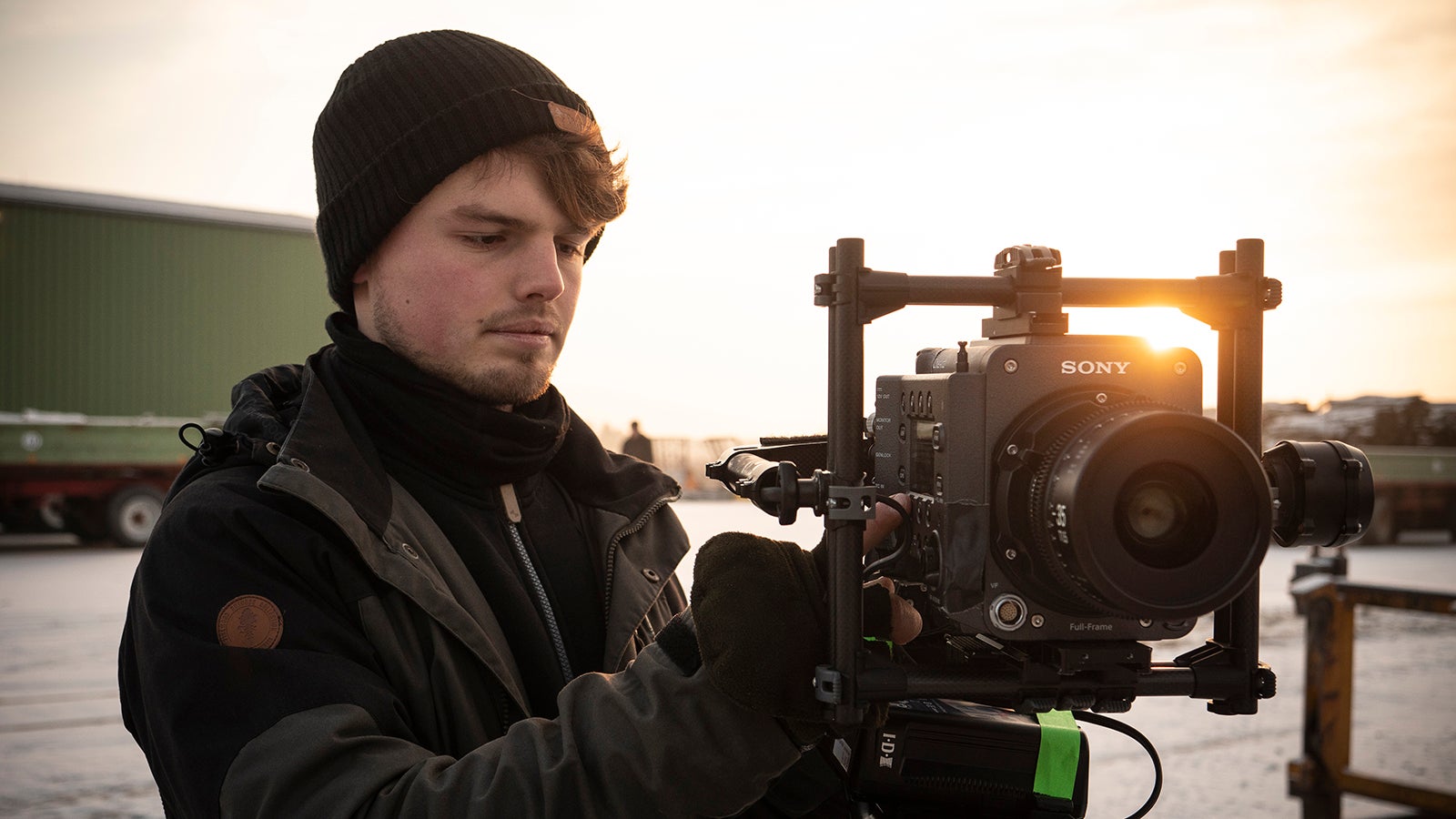
Jeffrey van Houten, Camera Assistant
Tips on working in these kinds of conditions.
I remember spring this year. We walked on the beach of Texel. The wind force was 8-9 Beaufort (gale force, 68-82 km/h) and there was sand everywhere. We protected the camera with raincovers and the front element of the lens was protected with a SIGMA clear ceramic protection filter. The force of wind and sand was extreme. For example, we also used a mirrorless camera that same day and sand was blown through the lens mount and reached the sensor. Happily, everything survived and nothing was broken. The Sony VENICE and SIGMA Primes coped with all these conditions.
End-of-day routine, cleaning cameras and lenses.
We had to clean the equipment daily due to the ever-present salt in the air. At the end of the day, the camera, lenses, rigging and tripods had to be cleaned. I always tried to have a room with a bath, not for myself but for the equipment. I filled the bath (if available) with fresh water for the tripod legs and camera rigging. I washed down the tripod and let it soak in the bath for a while. Then, I started with a big brush on the camera to remove sand and salt grains followed by a microfiber cloth with alcohol to remove the salt, spray, mud, sand and other dirt. I cleaned the display and viewfinder of the camera the same way as the lenses.
For the SIGMA primes, I carefully used a blower brush to remove sand or salt grains on the surface. Next, I used a lens cleaning liquid on a microfiber cloth. First, I cleaned wet and then used a dry microfiber cloth to remove the last dirt from the surface of the lens. The bodies of the lenses were cleaned first with a brush, then alcohol on a microfiber cloth and then dried with another cloth. We left the lens cases open at night in the hotel room and we always had a few silica gel bags in the cases for additional drying.
Lens changes and preventing sand or salt getting on the sensor.
In the beginning of the shoot, we were very careful when changing lenses in windy and wet conditions. We even briefly thought of using zooms in the most precarious moments. Pieter-Rim canceled that idea immediately. “Stick to the plan,” he said. We discovered that using a small, dedicated handheld wind screen provided stable, dry and wind-free protection that did the job. But mostly it was also a matter of proper planning based on Pieter-Rim’s years of experience using of primes and knowledge what a certain focal length does and what he had in mind. I think we only had to clean the sensor about 5 times in 16 months.




